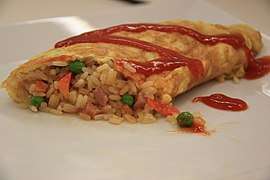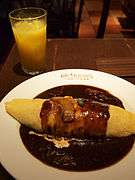Omurice
Omurice or omu-rice (オムライス, Omu-raisu) is an example of yōshoku (Western-influenced style of Japanese cuisine[1]) consisting of an omelet made with fried rice and thin, fried scrambled eggs, usually topped with ketchup.[2][3] It is a popular dish both commonly cooked at home and often found at western style diners in Japan. Children in particular enjoy omurice. It is often featured in Japan's version of a children's meal, okosama-ranchi (お子様ランチ).[1]
.jpg) Omurice is topped with ketchup | |
| Alternative names | Japanese Egg Roll Fried Rice |
|---|---|
| Place of origin | |
| Main ingredients | Chicken eggs, rice, ketchup |
| Variations | Omu Curry, Omuhayashi (with hayashi rice), Omu-Soba, Tampopo omurice |
Etymology
With omu and raisu being derived from the Japanese pronunciation of the English words omelet and rice,[4] the name is an example of wasei-eigo.
History
Omurice is said to have originated around the turn of the 20th century[4] at a western-style restaurant in Tokyo's Ginza district called Renga-tei, inspired by chakin-zushi.[5] The dish was brought to Korea and Taiwan, and it is popular cuisine.[6] It is a fixture on gimbap restaurant menus throughout South Korea, where it is rendered as "오므라이스 (omeuraiseu)" in Hangul.[7]
Variations
The dish typically consists of chikin raisu (chicken rice: rice pan-fried with ketchup and chicken) wrapped in a thin sheet of fried scrambled eggs. The ingredients flavoring the rice vary. Often, the rice is fried with various meats (but typically chicken) and/or vegetables, and can be flavored with beef stock, ketchup, demi-glace, white sauce or simply salt and pepper. Sometimes, rice is replaced with fried noodles (yakisoba) to make omusoba. A variant in Okinawa is omutako, consisting of an omelet over taco rice. Fried hot dog and Spam are also two popular meats to include in the dish.
 Models of various omurice dishes
Models of various omurice dishes On the inside
On the inside Omurice with demi-glace sauce.
Omurice with demi-glace sauce.
Similar dishes
A similar dish exists in Southeast Asia, especially in Malaysia, Indonesia and Singapore, and is called nasi goreng pattaya. It is a fried rice dish, covering chicken fried rice in thin fried egg or omelet.
Volga rice is another similar dish.[8]
In popular culture
A scene in the 1985 comedy film Tampopo shows omurice being made.
See also
- List of egg topics
- List of brunch foods
- List of Japanese foods
- List of Korean food
References
- "Omuraisu (also known as omurice or omu rice, Japanese rice omelet)", JustHungry.com.
- Nishimoto, Miyoko (June 1992). "Beyond Sushi: Japanese Cooking in the Great Home-Style Tradition", Vegetarian Times, No. 178. ISSN 0164-8497.
- Paxton, Norbert (2008). The Rough Guide to Korea, p.249. ISBN 978-1-4053-8420-9.
- Shimbo, Hiroko (2000). The Japanese Kitchen, p.148. ISBN 1-55832-177-2.
- Kishi Asako (March 15, 2002). "NIPPONIA No.20: Omuraisu", Web-Japan.org.
- For example, in Korea during Japanese rule. Sohn, Ho-min (2006). Korean language in culture and society, p.59. ISBN 9780824826949).
- Gail Jennings (October 2005). "Shokudo - An Unlikely Marriage of Comfort Foods". hawaiidiner.com. Archived from the original on 2010-10-31.)
- "Volga Rice - 【郷土料理ものがたり】". kyoudo-ryouri.com. Retrieved Jul 19, 2019.
External links
| Wikimedia Commons has media related to Omurice. |
- JunsKitchen. "Fluffy Omurice (Japanese Omelet Rice)", YouTube.com
- Setsuko Yoshizuka. "Omu Rice", JapaneseFood.About.com

